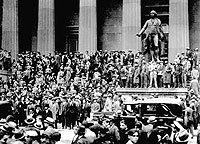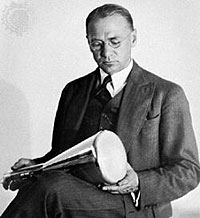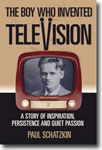

 |
The Farnsworth
Invention: Fact -v- Fiction
|
 |
Act II, Scenes 1: In which the plots thicken... and begin to diverge from the facts |
| The Play |
The Facts
|
|
"Wall Street Lays An Egg" |
Or so said the headline of the Daily Variety after the market crash, which saw RCA's stock plunge from a high $118 to $42. |  Crowds gather outside the New York Stock Exchange - October 29, 1929 |
| In the wreckage of the stock market crash, Farnsworth and Sarnoff begin to debate the circumstances of a pivotal event: Zworykin's visit to Farnsworth's laboratory. Farnsworth accuses Sarnoff with "industrial espionage," Sarnoff defends his actions as "opposition research." | Left out of the debate on stage is the most important detail: that Zworykin was still believed to be working for Westinghouse when he came to Farnsworth's lab in San Francisco. The difference is important, because Westinghouse had a history of licensing patents, and so was a potential customer of Farnsworth's patent portfolio. Had Zworykin show his true colors, that he was in fact en-route to RCA -- a potential competitor -- Farnsworth might have been considerably less forthcoming with his visitor. |
 By 1930, Zworykin had developed a receiver tube -- the kinescope -- but still did not have a camera capable of producing the resolution the receiver could display. |
| Farnsworth defends his invitation to Zworykin because he had "a light problem." Sarnoff reiterates, "a huge light problem." | Farnsworth welcomed Zworykin to his lab because Westinghouse was a potential licensor for his patents. Solving a "light problem" had nothing to do with it. Farnsworth's system of electronic television, and the pictures it rendered, improved steadily with the addition of myriad improvements, many of them adding valuable components to the company's patent portfolio. | |
| The play now focuses on Farnsworth's supposed inability to produce a satisfactory picture, due to his "light problem." Farnsworth is portrayed as sleeping only a few hours a night, on a cot in his lab. | Omitted from the chronology is Farnsworth's move from San Francisco to Philadelphia in 1931. Farnsworth moved east as part of a patent license agreement with the Philco Radio Company (no, NOT named for Philo). Philco hoped its sponsorship of Farnsworth would lead to advances that would give Philco an advantage over RCA in the new field of television. The arrangement was suitable for Farnsworth because it enabled him to hang on to, rather than sell, his growing portfolio if valuable patents. Unfortunately Philco turned out to be a less than ideal work environment for Farnsworth and his 'cowboys' from out west. |
Philco's classic "Cathedral" style radio outsold ever other model in the 1920s -- a source of endless frustration for Sarnoff and RCA, despite the patent royalties they collected on every unit sold. |
Want the whole story? Read a Book! |
 The Boy Who Invented Television A Story of Inspiration, Persistence, and Quiet Passion by Paul Schatzkin |
|